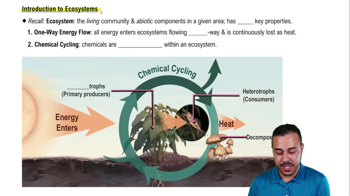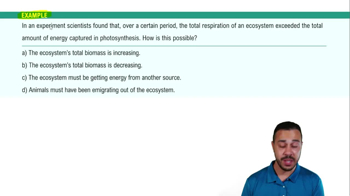Table of contents
- 1. Introduction to Biology2h 40m
- 2. Chemistry3h 40m
- 3. Water1h 26m
- 4. Biomolecules2h 23m
- 5. Cell Components2h 26m
- 6. The Membrane2h 31m
- 7. Energy and Metabolism2h 0m
- 8. Respiration2h 40m
- 9. Photosynthesis2h 49m
- 10. Cell Signaling59m
- 11. Cell Division2h 47m
- 12. Meiosis2h 0m
- 13. Mendelian Genetics4h 41m
- Introduction to Mendel's Experiments7m
- Genotype vs. Phenotype17m
- Punnett Squares13m
- Mendel's Experiments26m
- Mendel's Laws18m
- Monohybrid Crosses16m
- Test Crosses14m
- Dihybrid Crosses20m
- Punnett Square Probability26m
- Incomplete Dominance vs. Codominance20m
- Epistasis7m
- Non-Mendelian Genetics12m
- Pedigrees6m
- Autosomal Inheritance21m
- Sex-Linked Inheritance43m
- X-Inactivation9m
- 14. DNA Synthesis2h 27m
- 15. Gene Expression3h 20m
- 16. Regulation of Expression3h 31m
- Introduction to Regulation of Gene Expression13m
- Prokaryotic Gene Regulation via Operons27m
- The Lac Operon21m
- Glucose's Impact on Lac Operon25m
- The Trp Operon20m
- Review of the Lac Operon & Trp Operon11m
- Introduction to Eukaryotic Gene Regulation9m
- Eukaryotic Chromatin Modifications16m
- Eukaryotic Transcriptional Control22m
- Eukaryotic Post-Transcriptional Regulation28m
- Eukaryotic Post-Translational Regulation13m
- 17. Viruses37m
- 18. Biotechnology2h 58m
- 19. Genomics17m
- 20. Development1h 5m
- 21. Evolution3h 1m
- 22. Evolution of Populations3h 52m
- 23. Speciation1h 37m
- 24. History of Life on Earth2h 6m
- 25. Phylogeny2h 31m
- 26. Prokaryotes4h 59m
- 27. Protists1h 12m
- 28. Plants1h 22m
- 29. Fungi36m
- 30. Overview of Animals34m
- 31. Invertebrates1h 2m
- 32. Vertebrates50m
- 33. Plant Anatomy1h 3m
- 34. Vascular Plant Transport2m
- 35. Soil37m
- 36. Plant Reproduction47m
- 37. Plant Sensation and Response1h 9m
- 38. Animal Form and Function1h 19m
- 39. Digestive System10m
- 40. Circulatory System1h 57m
- 41. Immune System1h 12m
- 42. Osmoregulation and Excretion50m
- 43. Endocrine System4m
- 44. Animal Reproduction2m
- 45. Nervous System55m
- 46. Sensory Systems46m
- 47. Muscle Systems23m
- 48. Ecology3h 11m
- Introduction to Ecology20m
- Biogeography14m
- Earth's Climate Patterns50m
- Introduction to Terrestrial Biomes10m
- Terrestrial Biomes: Near Equator13m
- Terrestrial Biomes: Temperate Regions10m
- Terrestrial Biomes: Northern Regions15m
- Introduction to Aquatic Biomes27m
- Freshwater Aquatic Biomes14m
- Marine Aquatic Biomes13m
- 49. Animal Behavior28m
- 50. Population Ecology3h 41m
- Introduction to Population Ecology28m
- Population Sampling Methods23m
- Life History12m
- Population Demography17m
- Factors Limiting Population Growth14m
- Introduction to Population Growth Models22m
- Linear Population Growth6m
- Exponential Population Growth29m
- Logistic Population Growth32m
- r/K Selection10m
- The Human Population22m
- 51. Community Ecology2h 46m
- Introduction to Community Ecology2m
- Introduction to Community Interactions9m
- Community Interactions: Competition (-/-)38m
- Community Interactions: Exploitation (+/-)23m
- Community Interactions: Mutualism (+/+) & Commensalism (+/0)9m
- Community Structure35m
- Community Dynamics26m
- Geographic Impact on Communities21m
- 52. Ecosystems2h 36m
- 53. Conservation Biology24m
48. Ecology
Introduction to Ecology
Problem 1b
Textbook Question
Textbook QuestionWhich of the following areas of study focuses on the exchange of energy, organisms, and materials between ecosystems? a. organismal ecology b. landscape ecology c. ecosystem ecology d. community ecology
 Verified step by step guidance
Verified step by step guidance1
Step 1: Understand the question. The question is asking which area of study in ecology focuses on the exchange of energy, organisms, and materials between ecosystems.
Step 2: Review the options. Organismal ecology focuses on individual organisms and their behaviors. Landscape ecology examines the effects of spatial variation within ecosystems. Ecosystem ecology studies the flow of energy and nutrients within an ecosystem. Community ecology focuses on the interactions between species within a community.
Step 3: Compare the options with the question. The question is asking about the exchange of energy, organisms, and materials between ecosystems, not within a single ecosystem or between individual organisms.
Step 4: Choose the correct answer. Based on the definitions, the correct answer is landscape ecology because it focuses on the interactions between different ecosystems.
Step 5: Confirm the answer. Landscape ecology is indeed the study of how landscape structure affects the abundance, distribution, and interaction of organisms. Therefore, the answer is b. landscape ecology.
Recommended similar problem, with video answer:
 Verified Solution
Verified SolutionThis video solution was recommended by our tutors as helpful for the problem above
Video duration:
1mPlay a video:
Was this helpful?
Key Concepts
Here are the essential concepts you must grasp in order to answer the question correctly.
Ecosystem Ecology
Ecosystem ecology is the study of how energy and nutrients flow through ecosystems, focusing on the interactions between living organisms and their physical environment. It examines processes such as energy transfer, nutrient cycling, and the dynamics of populations within ecosystems. This field emphasizes the importance of both biotic (living) and abiotic (non-living) components in maintaining ecosystem health and function.
Recommended video:
Guided course

Introduction to Ecosystems
Energy Flow
Energy flow refers to the transfer of energy through a food chain or food web, starting from primary producers (like plants) that convert solar energy into chemical energy via photosynthesis. This energy is then passed on to consumers (herbivores and carnivores) and decomposers. Understanding energy flow is crucial for analyzing how ecosystems function and how energy is utilized and transformed within them.
Recommended video:
Guided course

Energy Flow Through Ecosystems Example 1
Nutrient Cycling
Nutrient cycling is the process by which essential nutrients are recycled within ecosystems, involving biological, geological, and chemical processes. Key cycles include the carbon, nitrogen, and phosphorus cycles, which describe how these elements move through the environment and are utilized by organisms. This concept is vital for understanding ecosystem productivity and sustainability, as it highlights the interconnectedness of life and the environment.
Recommended video:
Guided course

Soil Nutrients

 2:54m
2:54mWatch next
Master What is Ecology? with a bite sized video explanation from Jason Amores Sumpter
Start learningRelated Videos
Related Practice































































































